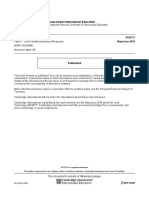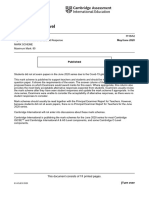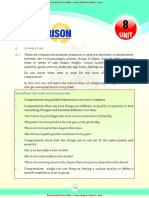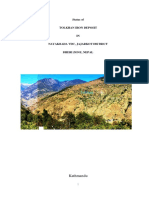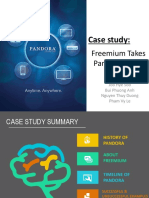Cambridge Assessment International Education: Accounting 9706/32 May/June 2018
Cambridge Assessment International Education: Accounting 9706/32 May/June 2018
Uploaded by
Tesa RudangtaCopyright:
Available Formats
Cambridge Assessment International Education: Accounting 9706/32 May/June 2018
Cambridge Assessment International Education: Accounting 9706/32 May/June 2018
Uploaded by
Tesa RudangtaOriginal Title
Copyright
Available Formats
Share this document
Did you find this document useful?
Is this content inappropriate?
Copyright:
Available Formats
Cambridge Assessment International Education: Accounting 9706/32 May/June 2018
Cambridge Assessment International Education: Accounting 9706/32 May/June 2018
Uploaded by
Tesa RudangtaCopyright:
Available Formats
Cambridge Assessment International Education
Cambridge International Advanced Subsidiary and Advanced Level
ACCOUNTING 9706/32
Paper 3 Structured Questions May/June 2018
MARK SCHEME
Maximum Mark: 150
Published
This mark scheme is published as an aid to teachers and candidates, to indicate the requirements of the
examination. It shows the basis on which Examiners were instructed to award marks. It does not indicate the
details of the discussions that took place at an Examiners’ meeting before marking began, which would have
considered the acceptability of alternative answers.
bestexamhelp.com
Mark schemes should be read in conjunction with the question paper and the Principal Examiner Report for
Teachers.
Cambridge International will not enter into discussions about these mark schemes.
Cambridge International is publishing the mark schemes for the May/June 2018 series for most
Cambridge IGCSE™, Cambridge International A and AS Level and Cambridge Pre-U components, and
some Cambridge O Level components.
IGCSE™ is a registered trademark.
This document consists of 17 printed pages.
© UCLES 2018 [Turn over
9706/32 Cambridge International AS/A Level – Mark Scheme May/June 2018
PUBLISHED
Generic Marking Principles
These general marking principles must be applied by all examiners when marking candidate answers. They should be applied alongside the
specific content of the mark scheme or generic level descriptors for a question. Each question paper and mark scheme will also comply with these
marking principles.
GENERIC MARKING PRINCIPLE 1:
Marks must be awarded in line with:
• the specific content of the mark scheme or the generic level descriptors for the question
• the specific skills defined in the mark scheme or in the generic level descriptors for the question
• the standard of response required by a candidate as exemplified by the standardisation scripts.
GENERIC MARKING PRINCIPLE 2:
Marks awarded are always whole marks (not half marks, or other fractions).
GENERIC MARKING PRINCIPLE 3:
Marks must be awarded positively:
• marks are awarded for correct/valid answers, as defined in the mark scheme. However, credit is given for valid answers which go beyond the
scope of the syllabus and mark scheme, referring to your Team Leader as appropriate
• marks are awarded when candidates clearly demonstrate what they know and can do
• marks are not deducted for errors
• marks are not deducted for omissions
• answers should only be judged on the quality of spelling, punctuation and grammar when these features are specifically assessed by the
question as indicated by the mark scheme. The meaning, however, should be unambiguous.
GENERIC MARKING PRINCIPLE 4:
Rules must be applied consistently e.g. in situations where candidates have not followed instructions or in the application of generic level
descriptors.
© UCLES 2018 Page 2 of 17
9706/32 Cambridge International AS/A Level – Mark Scheme May/June 2018
PUBLISHED
GENERIC MARKING PRINCIPLE 5:
Marks should be awarded using the full range of marks defined in the mark scheme for the question (however; the use of the full mark range may
be limited according to the quality of the candidate responses seen).
GENERIC MARKING PRINCIPLE 6:
Marks awarded are based solely on the requirements as defined in the mark scheme. Marks should not be awarded with grade thresholds or
grade descriptors in mind.
© UCLES 2018 Page 3 of 17
9706/32 Cambridge International AS/A Level – Mark Scheme May/June 2018
PUBLISHED
Question Answer Marks
1(a)(i) 12 000 units × $80 = $960 000 (1) 1
1(a)(ii) 12 000 units × $50 = $600 000 (1) 1
1(a)(iii) $80 000 × 1.5 = $120 000 (1) 1
1(a)(iv) Opening inventory = 1500 units × $50 = $75 000 (1) 3
Closing inventory = 3500 units × $50 = $175 000 (1)
Average = $125 000 (1) OF
1(b) It calculates the number of days between paying for goods purchased (1) and receiving the money for goods sold (1). 2
Or: The number of days to convert the net current assets (1) into cash (1)
1(c) 125 000 7
Inventory turnover = (1) OF × 365 = 76.04 days / 77 days (1) OF
600 000
120 000
Trade receivables collection = (1) OF × 365 = 45.63 days / 46 days (1) OF
960 000
62 000
Trade payables payment = (1) × 365 = 32.33 days / 33 days (1)
700 000
Working capital cycle =77 + 46 – 33 = 90 days (1) OF
1(d) New revenue = 12 000 at $90 = $1 080 000 (1) 5
New trade receivables = $90 000 (1)
New trade receivables collection = 90 000 (1) OF × 365 = 30.42 days / 31 days (1) OF
1080 000
New working capital cycle =77 + 31 – 33 = 75 days (1) OF
or 90 – 46 +31 = 75 days (1) OF
© UCLES 2018 Page 4 of 17
9706/32 Cambridge International AS/A Level – Mark Scheme May/June 2018
PUBLISHED
Question Answer Marks
1(e) Strategy would reduce/improve the working capital cycle (1) OF by 15 days (1) OF 5
The liquidity of the business has improved (1)
The strategy would reduce the overdraft (1)
The business would benefit from a lower working capital cycle (1)
Profitability would increase (1)
May not be realistic to expect no change in demand (1)
Not all customers may take the discount (1)
Accept other valid points.
Decision (1) and max 4 marks for discussion.
© UCLES 2018 Page 5 of 17
9706/32 Cambridge International AS/A Level – Mark Scheme May/June 2018
PUBLISHED
Question Answer Marks
2(a) 15
N plc
Income Statement for the year ended 31 December 2017
$ $
Revenue 2 348 000 (1)
Cost of sales
Opening inventory 241 000 )
Purchases 1 322 000 )(1)
Closing inventory (259 200) (1) 1 303 800 (1) OF
Gross profit 1 044 200 (1) OF
Distribution costs (296 000)
Administrative expenses (W1) (711 000) (7)
Profit from operations 37 200 (1) OF
Finance charge (12 000) (1)
Profit for the year 25 200 (1) OF
W1 Administrative expenses
Per trial balance 674 000
Dividend paid (30 000) (1)
Depreciation on building ($720 000 × 1/3 (1) ) / 16 years (1) 15 000 (1)OF
Depreciation on equipment ($278 000 + $10 000 – $40 000) (1) × 25% 62 000 (1)
Profit on disposal of equipment (10 000) (1)
711 000
© UCLES 2018 Page 6 of 17
9706/32 Cambridge International AS/A Level – Mark Scheme May/June 2018
PUBLISHED
Question Answer Marks
2(b) $ $ 5
Land and buildings – revalued amount 720 000 (1)
Land and buildings – original cost 600 000 (1)
Accumulated depreciation at 1 January 2017 (72 000) (1)
528 000 (1)
Revaluation reserve at 1 January 2017 192 000 (1) OF
Or – alternative presentation
$ $
Land and buildings – revalued amount 720 000 (1)
Less: land and buildings – original cost (600 000) (1)
120 000 (1)
Add: accumulated depreciation at 1 January 2017 72 000 (1)
Revaluation reserve at 1 January 2017 192 000 (1) OF
2(c) 2017 financial statements 3
non-adjusting event
IAS 10
disclosure only/included as a note
2018 financial statements
write off/decrease the value of the asset
1 mark for each valid point but max 2 for 2017 comments
2(d) An impairment loss is the amount by which the carrying amount (1) of an asset exceeds its recoverable amount (1) 2
© UCLES 2018 Page 7 of 17
9706/32 Cambridge International AS/A Level – Mark Scheme May/June 2018
PUBLISHED
Question Answer Marks
3(a) $ 2
Purchase cost 175 000
Freight 15 400
Insurance 3 200
Import duty 1 600
Carriage inwards 2 800
198 000 (1)
198 000
Cost per unit = = $198 (1) OF
1000
© UCLES 2018 Page 8 of 17
9706/32 Cambridge International AS/A Level – Mark Scheme May/June 2018
PUBLISHED
Question Answer Marks
3(b) Consignment account 13
$ $
Goods sent on consignment 175 000 (1) Cash sales 480 × $257.5 123 600 )
Bank Credit sales 320 × $270 86 400 )(1)
Freight 15 400 ) Balance c/d (W1) 36 720 (4) OF
Insurance 3 200 )(1)
Mahood
Carriage inwards 2 800 )
Import duty 1 600 )(1)
Advertising 9 700 )
Carriage outwards 3 300 )(1)
Bad debt 16 × $270 4 320 (1)
Commission (W2) 10 000 (2)
Income statement 21 400 (1) OF
246 720 246 720
W1 Closing inventory $
(1 000 – 480 – 320 – 60) = 140 (1) × $198 (1) OF 27 720
60 × $150 9 000 (1)
36 720 (1) OF
W2 Commission
Total sales $123 600 + $86 400 = $210 000 (1)
a = 5% × ($210 000 – a)
a = $10 000 (1)
© UCLES 2018 Page 9 of 17
9706/32 Cambridge International AS/A Level – Mark Scheme May/June 2018
PUBLISHED
Question Answer Marks
3(c) The consignee – Mahood 5
$ $
Cash sales 123 600 )
Credit sales 86 400 )(1) OF Bank – Advance payment 55 000 (1)
Import duty 1 600
Carriage inwards 2 800
Advertising 9 700
Carriage outwards 3 300
Bad debt 4 320 (1) OF
Commission 10 000 (1) OF
Bank to Y Limited (balance) 123 280 (1) OF
210 000 210 000
3(d) Consigning goods to Mahood 5
can test the overseas market before investing heavily
there would be no initial set up costs of a branch
the current consignment arrangements are profitable
existing customer base/reputation/knowledge of existing market is already established
less risk in terms of overseas economic, political, cultural and social environment
Opening a branch overseas
would have complete control of the business activities, i.e. marketing strategy
there would be a saving of commission to Mahood
allows expansion overseas if local market is saturated.
(Max 2 marks) for discussing consigning goods and (Max 2 marks) for discussing overseas branch;
(1 mark) for recommendation.
© UCLES 2018 Page 10 of 17
9706/32 Cambridge International AS/A Level – Mark Scheme May/June 2018
PUBLISHED
Question Answer Marks
4(a) Ephraim and Fikriyah 13
Statement of financial position at 1 October 2017
$ $
Non-current assets 170 000 (1)
Current assets
Inventories 18 500 (1)
Trade receivables 24 500
Cash and cash equivalents 7 500 50 500 (1)
Total assets 220 500 (1) OF
Capital and liabilities
Capital accounts (W1):
Ephraim 72 500
Fikriyah 122 000 194 500 (8)
Current liabilities
Trade payables 26 000 (1)
Total equity and liabilities 220 500
Capital accounts
W1 Ephraim Fikriyah
$ $
Balance b/d 60 000 120 000 (1) both
Goodwill 10 000 6 000 (1) both
Goodwill (8 000) (1) (8 000) (1)
Non-current assets 10 000 5 000 (1) both
Inventories 500 (1 000) (1) both
72 500 (1) OF 122 000 (1) OF
© UCLES 2018 Page 11 of 17
9706/32 Cambridge International AS/A Level – Mark Scheme May/June 2018
PUBLISHED
Question Answer Marks
4(b) As profits are shared equally both Ephraim and Fikriyah would receive $50 000 in the first year. (1) 12
Second year profits are $90 000 (1), third year $81 000 (1) and fourth year $72 900. (1)
Ephraim is worse off (throughout the period). (1)
Fikriyah is better off for years one, two and three (1) but is also worse off in year four. (1)
Fikriyah is contributing significantly more capital but only receiving half the profit (1) OF
The profits may not have been maintained by the sole traders for this four-year period (1)
It would appear that the merger is beneficial for Fikriyah/not for Ephraim. (1)
The partners should take action to reverse the trend in falling profit (1)
The synergies from partnership will make it more efficient (1)
Accept other valid points.
© UCLES 2018 Page 12 of 17
9706/32 Cambridge International AS/A Level – Mark Scheme May/June 2018
PUBLISHED
Question Answer Marks
5(a)(i) Net cash Discount Discounted 12
Year Inflows Outflows
flow factor cash flows
0 100 000 (100 000) (100 000) (1)
1 180 000 (1) (180 000) 0.909 (163 620) (1) OF
2 35 000 } 15 500 (1) 19 500 0.826 16 107 (1) OF
3 40 000 } (1) 16 000 (1) 24 000 0.751 18 024 (1) OF
4 50 000 17 000 (1) 33 000 0.683 22 539 (1) OF
(206 950)
4 290 000 0.683 198 070 (1)
NPV (8 880) (1) OF
5(a)(ii) Net cash Discount Discounted 3
Year Inflows Outflows
flow factor cash flows
Discounted cash flows before sales proceeds (206 950) (1) OF
4 315 000 0.683 215 145 (1)
NPV 8 195 (1) OF
5(b) 206 950 (1) OF = $303 001 (1) OF 3
0.683 (1)
© UCLES 2018 Page 13 of 17
9706/32 Cambridge International AS/A Level – Mark Scheme May/June 2018
PUBLISHED
Question Answer Marks
5(c) Both positive and negative NPVs are small in relation to the outlay. 5
Decision would depend on how risk-averse Jason is.
The project pays back even at the lower sales value.
There are a lot of assumptions being made even without the final sales proceeds.
Jason may get more for the building if he sold the flats individually rather than as a block.
Accept other valid points.
(1) for decision and (max 4) for comments
5(d) Payback ignores the time value of money 2
Payback ignores the length of a project
Payback ignores cash flows arising after the payback period
Projects with the same NPVs could have different patterns of cash movements and hence have different payback periods.
Accept other valid points.
Any two for (1) mark each
© UCLES 2018 Page 14 of 17
9706/32 Cambridge International AS/A Level – Mark Scheme May/June 2018
PUBLISHED
Question Answer Marks
6(a) Responses could include: 2
the setting of standards is time consuming/costly e.g. needs a specialist
standards need to be updated regularly as business conditions change rapidly
too high a standard may have a demotivating effect on staff
setting standards involves prediction which has an element of uncertainty/inaccurate
(1 mark) × 2 limitations
6(b)(i) Direct materials price variance $ 2
(15 360 × $80) – $1 190 400 38 400 (F)
6(b)(ii) Direct materials usage variance 2
(15 360 – 4800 × 3) × $80 76 800 (A)
6(b)(iii) Direct labour rate variance 2
(55 200 × $30) – $1 766 400 110 400 (A)
6(b)(iv) Direct labour efficiency variance 2
(55 200 – 4800 × 12) × $30 72 000 (F)
6(b)(v) Fixed overhead expenditure variance 2
$600 000 – $579 600 20 400 (F)
6(b)(vi) Fixed overhead volume variance 2
$600 000 – $576 000 24 000 (A)
© UCLES 2018 Page 15 of 17
9706/32 Cambridge International AS/A Level – Mark Scheme May/June 2018
PUBLISHED
Question Answer Marks
6(b) For reference:
$
Direct materials 3 × $80 240
Direct labour 12 × $30 360
Production overhead 12 × $10 120
Unit production cost 720
Static budget $
Direct materials 5 000 × $240 1 200 000
Direct labour 5 000 × $360 1 800 000
Production overhead 5 000 × $120 600 000
Production cost for 5 000 units 3 600 000
6(c) $ 8
Budgeted cost W1 3 456 000 (4) OF
Direct material price variance (38 400) } (1) OF
Direct material usage variance 76 800 }
Direct labour rate variance 110 400 } (1) OF
Direct labour efficiency variance (72 000) }
Fixed OH expenditure variance (20 400) } (1) OF
Fixed OH volume variance 24 000 }
Production cost 3 536 400 (1)
W1 Flexed budget $
Direct materials 4 800 × $240 1 152 000 (1)
Direct labour 4 800 × $360 1 728 000 (1)
Production overhead 4 800 × $120 576 000 (1)
Production cost for 4 800 units 3 456 000 (1) OF
© UCLES 2018 Page 16 of 17
9706/32 Cambridge International AS/A Level – Mark Scheme May/June 2018
PUBLISHED
Question Answer Marks
6(d) Increasing selling price may lose existing customers 3
May gain new customers looking for high quality product
Higher quality product will enhance the reputation of the business
Will adversely affect the material price variance
May improve material usage variance/less wastage
May further improve labour efficiency variance with the use of high quality materials
Accept other valid points.
(2) marks for justification and (1) mark for decision.
© UCLES 2018 Page 17 of 17
You might also like
- Cambridge Assessment International Education: This Document Consists of 19 Printed PagesNo ratings yetCambridge Assessment International Education: This Document Consists of 19 Printed Pages19 pages
- Cambridge Assessment International Education: Accounting 9706/33 October/November 2018No ratings yetCambridge Assessment International Education: Accounting 9706/33 October/November 201817 pages
- Cambridge Assessment International Education: Accounting 9706/21 October/November 2018No ratings yetCambridge Assessment International Education: Accounting 9706/21 October/November 201811 pages
- Cambridge Assessment International Education: Accounting 0452/21 October/November 2018No ratings yetCambridge Assessment International Education: Accounting 0452/21 October/November 201817 pages
- Cambridge Assessment International Education: Accounting 0452/21 May/June 2018No ratings yetCambridge Assessment International Education: Accounting 0452/21 May/June 201818 pages
- Cambridge Assessment International Education: Accounting 0452/21 October/November 2018No ratings yetCambridge Assessment International Education: Accounting 0452/21 October/November 201817 pages
- Cambridge International AS & A Level: Accounting 9706/31 May/June 2020No ratings yetCambridge International AS & A Level: Accounting 9706/31 May/June 202015 pages
- Cambridge International AS & A Level: Accounting 9706/31 May/June 2020No ratings yetCambridge International AS & A Level: Accounting 9706/31 May/June 20206 pages
- Cambridge International AS & A Level: Accounting 9706/31 May/June 2020No ratings yetCambridge International AS & A Level: Accounting 9706/31 May/June 20206 pages
- Cambridge Assessment International Education: Accounting 9706/32 October/November 2017No ratings yetCambridge Assessment International Education: Accounting 9706/32 October/November 201711 pages
- Cambridge Assessment International Education: Accounting 9706/32 March 2018No ratings yetCambridge Assessment International Education: Accounting 9706/32 March 201814 pages
- Cambridge Assessment International Education: Business Studies 0450/13 May/June 2018No ratings yetCambridge Assessment International Education: Business Studies 0450/13 May/June 201816 pages
- Cambridge Assessment International Education: Business Studies 0450/22 March 2018No ratings yetCambridge Assessment International Education: Business Studies 0450/22 March 201813 pages
- Cambridge Assessment International Education: Business 9609/11 October/November 2018No ratings yetCambridge Assessment International Education: Business 9609/11 October/November 201814 pages
- Cambridge Assessment International Education: Physics 0625/42 May/June 2018No ratings yetCambridge Assessment International Education: Physics 0625/42 May/June 201810 pages
- Cambridge IGCSE™: Accounting 0452/22 October/November 2020No ratings yetCambridge IGCSE™: Accounting 0452/22 October/November 202014 pages
- Cambridge O Level: Business Studies 7115/12 May/June 2020No ratings yetCambridge O Level: Business Studies 7115/12 May/June 202012 pages
- 0450 Business Studies: MARK SCHEME For The October/November 2013 SeriesNo ratings yet0450 Business Studies: MARK SCHEME For The October/November 2013 Series11 pages
- 1.june_2017_p1_2_mark_schemes_combined-mergedNo ratings yet1.june_2017_p1_2_mark_schemes_combined-merged136 pages
- BUSINESS STUDIES _mark_schemes_combinedNo ratings yetBUSINESS STUDIES _mark_schemes_combined28 pages
- Cambridge Assessment International Education: Business 9609/23 May/June 2018No ratings yetCambridge Assessment International Education: Business 9609/23 May/June 201811 pages
- Cambridge O Level: Accounting 7707/22 October/November 2020100% (1)Cambridge O Level: Accounting 7707/22 October/November 202014 pages
- Cambridge Assessment International Education: Physics 0625/43 May/June 2018No ratings yetCambridge Assessment International Education: Physics 0625/43 May/June 20189 pages
- Cambridge International AS & A Level: Accounting 9706/34 May/June 2021No ratings yetCambridge International AS & A Level: Accounting 9706/34 May/June 202113 pages
- Cambridge Assessment International Education: First Language English 0500/32 March 2018No ratings yetCambridge Assessment International Education: First Language English 0500/32 March 201812 pages
- Cambridge Assessment International Education: Business 9609/12 October/November 2017No ratings yetCambridge Assessment International Education: Business 9609/12 October/November 201710 pages
- Cambridge Assessment International Education: Accounting 9706/22 October/November 2018No ratings yetCambridge Assessment International Education: Accounting 9706/22 October/November 201812 pages
- Mark Scheme: Extra Assessment Material For First Teaching September 2017No ratings yetMark Scheme: Extra Assessment Material For First Teaching September 201713 pages
- 1.june_2017_p1_2_mark_schemes_combined-merged-convertedNo ratings yet1.june_2017_p1_2_mark_schemes_combined-merged-converted136 pages
- Cambridge IGCSE™: Business Studies 0450/11 October/November 2020No ratings yetCambridge IGCSE™: Business Studies 0450/11 October/November 202020 pages
- Cambridge IGCSE™: Business Studies 0450/13 October/November 2020No ratings yetCambridge IGCSE™: Business Studies 0450/13 October/November 202020 pages
- Cambridge Assessment International Education: Economics 0455/21 May/June 2018No ratings yetCambridge Assessment International Education: Economics 0455/21 May/June 201817 pages
- Practice Tests for CASAS Math GOAL 2 Level C, Forms 925M and 926MFrom EverandPractice Tests for CASAS Math GOAL 2 Level C, Forms 925M and 926MNo ratings yet
- Practice Tests for CASAS Math GOAL 2 Level B, Forms 923M and 924MFrom EverandPractice Tests for CASAS Math GOAL 2 Level B, Forms 923M and 924MNo ratings yet
- Wiley CMAexcel Learning System Exam Review 2015: Part 2, Financial Decision MakingFrom EverandWiley CMAexcel Learning System Exam Review 2015: Part 2, Financial Decision MakingNo ratings yet
- Practice Tests for CASAS Math GOAL 2 Level D, Forms 927M and 928MFrom EverandPractice Tests for CASAS Math GOAL 2 Level D, Forms 927M and 928MNo ratings yet
- Name: - Score: - Order The Following Numbers From Smallest To GreatestNo ratings yetName: - Score: - Order The Following Numbers From Smallest To Greatest1 page
- Name: - Score: - Compare and Order The Following Sets of NumbersNo ratings yetName: - Score: - Compare and Order The Following Sets of Numbers2 pages
- Name: - Score: - Circle All Possible Numbers That Can Be Filled inNo ratings yetName: - Score: - Circle All Possible Numbers That Can Be Filled in2 pages
- 4th Grade Comparing Numbers Up To 100,000 NC.4.NBT.7: 10 QuestionsNo ratings yet4th Grade Comparing Numbers Up To 100,000 NC.4.NBT.7: 10 Questions2 pages
- Expanded Form Up To 5-Digits Sheet 1A: Name DateNo ratings yetExpanded Form Up To 5-Digits Sheet 1A: Name Date1 page
- Occurence, Properties, Preparation, and Applications of Inorganic Compounds100% (4)Occurence, Properties, Preparation, and Applications of Inorganic Compounds8 pages
- Lewisburg Area School District Lesson PlanNo ratings yetLewisburg Area School District Lesson Plan2 pages
- Ryōhei Arisu Alice in Borderland Wiki FandomNo ratings yetRyōhei Arisu Alice in Borderland Wiki Fandom1 page
- Introduction To Technology and Innovation Week-1No ratings yetIntroduction To Technology and Innovation Week-127 pages
- Role of Nabard in Rural Development in IndiaNo ratings yetRole of Nabard in Rural Development in India9 pages
- Evaluating The Impact of Gamification and Virtual Reality On Patient Engagement and Outcomes in Rehabilitation ProgramsNo ratings yetEvaluating The Impact of Gamification and Virtual Reality On Patient Engagement and Outcomes in Rehabilitation Programs9 pages
- PQ PQ PQ PQ B/229 B/229 B/229 B/229 Parliamentary Parliamentary Parliamentary Parliamentary Questions Questions Questions Questions100% (1)PQ PQ PQ PQ B/229 B/229 B/229 B/229 Parliamentary Parliamentary Parliamentary Parliamentary Questions Questions Questions Questions6 pages
- Match A: Organized - By:, ICT Sector Trainers. Read For More Understanding, Only Chance Will Not Bring Satisfaction!No ratings yetMatch A: Organized - By:, ICT Sector Trainers. Read For More Understanding, Only Chance Will Not Bring Satisfaction!17 pages
- Cambridge Assessment International Education: This Document Consists of 19 Printed PagesCambridge Assessment International Education: This Document Consists of 19 Printed Pages
- Cambridge Assessment International Education: Accounting 9706/33 October/November 2018Cambridge Assessment International Education: Accounting 9706/33 October/November 2018
- Cambridge Assessment International Education: Accounting 9706/21 October/November 2018Cambridge Assessment International Education: Accounting 9706/21 October/November 2018
- Cambridge Assessment International Education: Accounting 0452/21 October/November 2018Cambridge Assessment International Education: Accounting 0452/21 October/November 2018
- Cambridge Assessment International Education: Accounting 0452/21 May/June 2018Cambridge Assessment International Education: Accounting 0452/21 May/June 2018
- Cambridge Assessment International Education: Accounting 0452/21 October/November 2018Cambridge Assessment International Education: Accounting 0452/21 October/November 2018
- Cambridge International AS & A Level: Accounting 9706/31 May/June 2020Cambridge International AS & A Level: Accounting 9706/31 May/June 2020
- Cambridge International AS & A Level: Accounting 9706/31 May/June 2020Cambridge International AS & A Level: Accounting 9706/31 May/June 2020
- Cambridge International AS & A Level: Accounting 9706/31 May/June 2020Cambridge International AS & A Level: Accounting 9706/31 May/June 2020
- Cambridge Assessment International Education: Accounting 9706/32 October/November 2017Cambridge Assessment International Education: Accounting 9706/32 October/November 2017
- Cambridge Assessment International Education: Accounting 9706/32 March 2018Cambridge Assessment International Education: Accounting 9706/32 March 2018
- Cambridge Assessment International Education: Business Studies 0450/13 May/June 2018Cambridge Assessment International Education: Business Studies 0450/13 May/June 2018
- Cambridge Assessment International Education: Business Studies 0450/22 March 2018Cambridge Assessment International Education: Business Studies 0450/22 March 2018
- Cambridge Assessment International Education: Business 9609/11 October/November 2018Cambridge Assessment International Education: Business 9609/11 October/November 2018
- Cambridge Assessment International Education: Physics 0625/42 May/June 2018Cambridge Assessment International Education: Physics 0625/42 May/June 2018
- Cambridge IGCSE™: Accounting 0452/22 October/November 2020Cambridge IGCSE™: Accounting 0452/22 October/November 2020
- Cambridge O Level: Business Studies 7115/12 May/June 2020Cambridge O Level: Business Studies 7115/12 May/June 2020
- 0450 Business Studies: MARK SCHEME For The October/November 2013 Series0450 Business Studies: MARK SCHEME For The October/November 2013 Series
- Cambridge Assessment International Education: Business 9609/23 May/June 2018Cambridge Assessment International Education: Business 9609/23 May/June 2018
- Cambridge O Level: Accounting 7707/22 October/November 2020Cambridge O Level: Accounting 7707/22 October/November 2020
- Cambridge Assessment International Education: Physics 0625/43 May/June 2018Cambridge Assessment International Education: Physics 0625/43 May/June 2018
- Cambridge International AS & A Level: Accounting 9706/34 May/June 2021Cambridge International AS & A Level: Accounting 9706/34 May/June 2021
- Cambridge Assessment International Education: First Language English 0500/32 March 2018Cambridge Assessment International Education: First Language English 0500/32 March 2018
- Cambridge Assessment International Education: Business 9609/12 October/November 2017Cambridge Assessment International Education: Business 9609/12 October/November 2017
- Cambridge Assessment International Education: Accounting 9706/22 October/November 2018Cambridge Assessment International Education: Accounting 9706/22 October/November 2018
- Mark Scheme: Extra Assessment Material For First Teaching September 2017Mark Scheme: Extra Assessment Material For First Teaching September 2017
- 1.june_2017_p1_2_mark_schemes_combined-merged-converted1.june_2017_p1_2_mark_schemes_combined-merged-converted
- Cambridge IGCSE™: Business Studies 0450/11 October/November 2020Cambridge IGCSE™: Business Studies 0450/11 October/November 2020
- Cambridge IGCSE™: Business Studies 0450/13 October/November 2020Cambridge IGCSE™: Business Studies 0450/13 October/November 2020
- Cambridge Assessment International Education: Economics 0455/21 May/June 2018Cambridge Assessment International Education: Economics 0455/21 May/June 2018
- Practice Tests for CASAS Math GOAL 2 Level C, Forms 925M and 926MFrom EverandPractice Tests for CASAS Math GOAL 2 Level C, Forms 925M and 926M
- Practice Tests for CASAS Math GOAL 2 Level B, Forms 923M and 924MFrom EverandPractice Tests for CASAS Math GOAL 2 Level B, Forms 923M and 924M
- Wiley CMAexcel Learning System Exam Review 2015: Part 2, Financial Decision MakingFrom EverandWiley CMAexcel Learning System Exam Review 2015: Part 2, Financial Decision Making
- Tips and Traps For Writing an Effective Business PlanFrom EverandTips and Traps For Writing an Effective Business Plan
- Practice Tests for CASAS Math GOAL 2 Level D, Forms 927M and 928MFrom EverandPractice Tests for CASAS Math GOAL 2 Level D, Forms 927M and 928M
- Name: - Score: - Order The Following Numbers From Smallest To GreatestName: - Score: - Order The Following Numbers From Smallest To Greatest
- Name: - Score: - Compare and Order The Following Sets of NumbersName: - Score: - Compare and Order The Following Sets of Numbers
- Name: - Score: - Circle All Possible Numbers That Can Be Filled inName: - Score: - Circle All Possible Numbers That Can Be Filled in
- 4th Grade Comparing Numbers Up To 100,000 NC.4.NBT.7: 10 Questions4th Grade Comparing Numbers Up To 100,000 NC.4.NBT.7: 10 Questions
- Occurence, Properties, Preparation, and Applications of Inorganic CompoundsOccurence, Properties, Preparation, and Applications of Inorganic Compounds
- Evaluating The Impact of Gamification and Virtual Reality On Patient Engagement and Outcomes in Rehabilitation ProgramsEvaluating The Impact of Gamification and Virtual Reality On Patient Engagement and Outcomes in Rehabilitation Programs
- PQ PQ PQ PQ B/229 B/229 B/229 B/229 Parliamentary Parliamentary Parliamentary Parliamentary Questions Questions Questions QuestionsPQ PQ PQ PQ B/229 B/229 B/229 B/229 Parliamentary Parliamentary Parliamentary Parliamentary Questions Questions Questions Questions
- Match A: Organized - By:, ICT Sector Trainers. Read For More Understanding, Only Chance Will Not Bring Satisfaction!Match A: Organized - By:, ICT Sector Trainers. Read For More Understanding, Only Chance Will Not Bring Satisfaction!




















